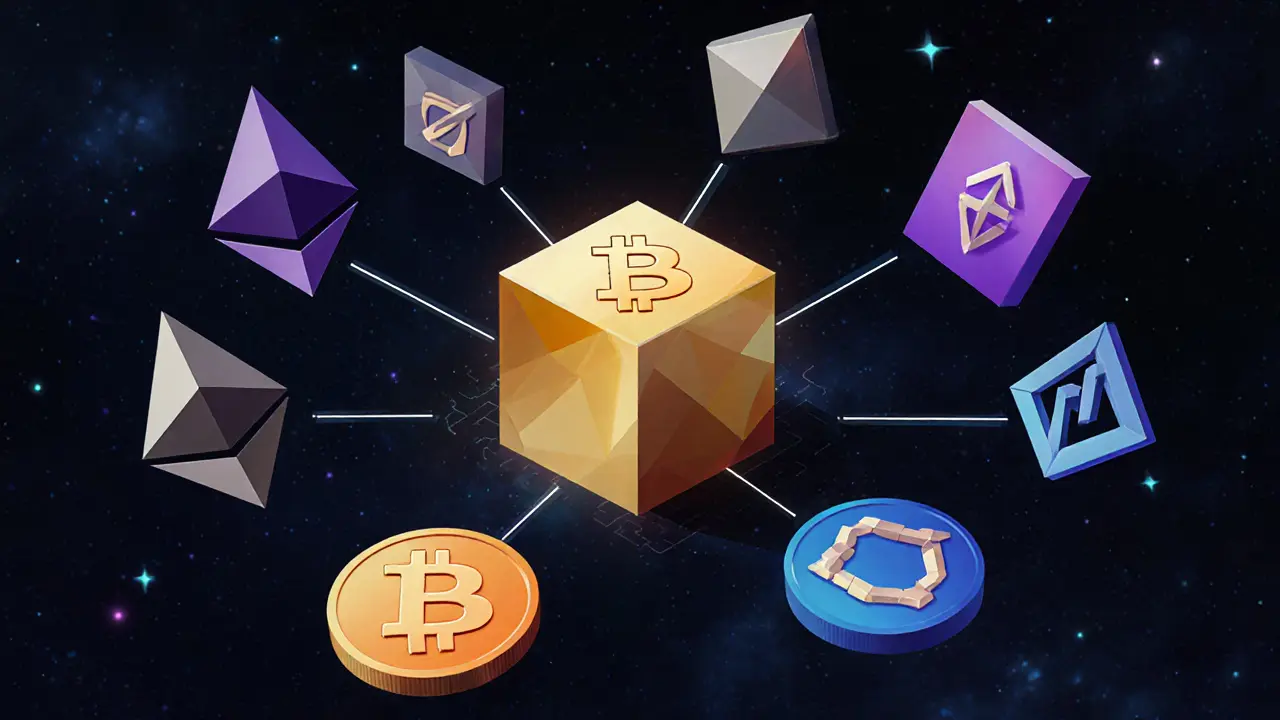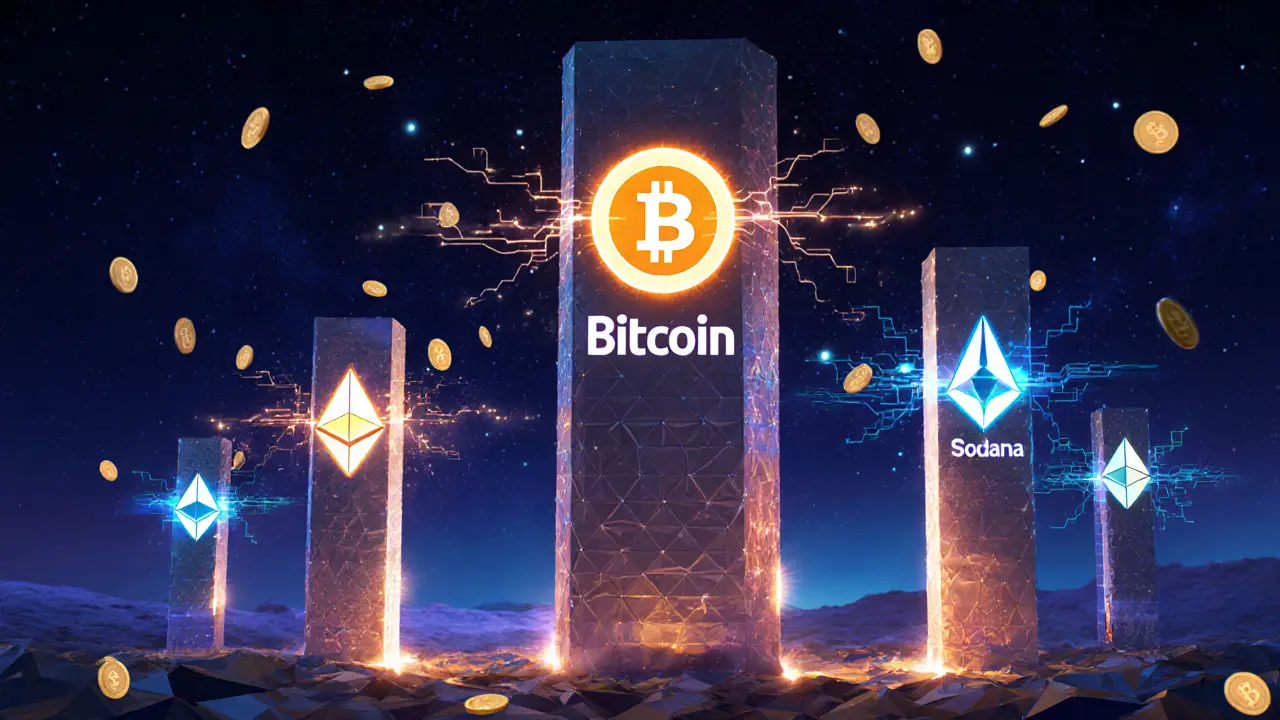What Is Altcoin? Understanding Alternative Cryptocurrencies Beyond Bitcoin

Altcoin Portfolio Calculator
Portfolio Allocation Guide
Experts recommend keeping 70-80% of your crypto portfolio in Bitcoin and Ethereum combined, and limiting altcoin exposure to 10-20%.
Important: Never invest more than you can afford to lose. 95% of altcoins fail.
Calculate Your Portfolio
Recommended Allocation
When people talk about altcoin, they’re not referring to one specific coin called ALT. That’s a common mistake. Altcoin is a category - a label for every cryptocurrency that came after Bitcoin. Think of it like smartphones: Bitcoin was the first iPhone. Everything else - Android phones, Samsung Galaxies, Pixel devices - they’re all "alternatives." That’s what altcoins are.
Bitcoin launched in January 2009. By 2011, developers started building new blockchains with different goals. Namecoin was the first, trying to create a decentralized domain name system. Litecoin followed later that year, promising faster transactions. Since then, thousands more have appeared. As of October 2025, there are over 25,000 cryptocurrencies listed. Almost all of them - except Bitcoin - are altcoins.
Why Do Altcoins Exist?
Bitcoin was groundbreaking, but it wasn’t perfect. It’s slow. It takes about 10 minutes to confirm a transaction. It uses a lot of electricity. And it can’t run complex programs like apps or contracts. Altcoins were built to fix those problems.
Ethereum, launched in 2015, changed everything. It didn’t just send money - it let developers build apps on top of its blockchain. These are called dApps. Today, most decentralized finance (DeFi) platforms, NFT marketplaces, and DAOs run on Ethereum. That’s why many experts now treat Ethereum as its own category, separate from other altcoins.
Other altcoins solved different problems. Monero hides transaction details so no one can trace who sent what. Ripple (XRP) was designed for banks to move money fast across borders. Solana promises to process 65,000 transactions per second - way faster than Bitcoin’s 7. Chainlink connects blockchains to real-world data like stock prices and weather reports. Each altcoin has a job.
How Altcoins Are Different From Bitcoin
Here’s a quick breakdown of how Bitcoin stacks up against major altcoins:
| Feature | Bitcoin (BTC) | Ethereum (ETH) | Solana (SOL) | Litecoin (LTC) | Monero (XMR) |
|---|---|---|---|---|---|
| Launch Year | 2009 | 2015 | 2020 | 2011 | 2014 |
| Consensus | Proof-of-Work | Proof-of-Stake | Proof-of-History | Proof-of-Work | Proof-of-Work (Privacy-focused) |
| Block Time | 10 minutes | 12 seconds | 400 milliseconds | 2.5 minutes | 2 minutes |
| Max Supply | 21 million | No hard cap | 489 million | 84 million | No hard cap |
| Primary Use | Digital gold, store of value | Smart contracts, DeFi, dApps | Fast, low-cost transactions | Peer-to-peer payments | Private transactions |
| Transaction Speed (TPS) | 4-7 | 15-30 | 2,000-3,000 | 28 | 20 |
Bitcoin’s main job is to be digital money that holds value. Altcoins are trying to do more: automate contracts, protect privacy, speed up payments, or connect blockchains to the real world. That’s why they’re not direct competitors - they’re complements.
Market Reality: Bitcoin and Ethereum Dominate
Even though there are 25,000+ altcoins, the market is far from evenly split. As of October 2025, Bitcoin holds about 54% of the total cryptocurrency market cap. Ethereum is second, with around 18%. Together, they make up over 70% of the entire crypto market.
The next biggest altcoin - BNB or Solana - sits at about 5%. The rest? Hundreds of coins each have less than 1%. This isn’t random. Most altcoins fail. A 2023 study by Token Metrics found that 95% of altcoins have no real users, no active development, and no chance of surviving a bear market. Only projects with working code, real teams, and clear use cases last.
That’s why some analysts now say "altcoin" only means coins that aren’t Bitcoin or Ethereum. It’s not a rule - it’s a practical way to talk about the rest of the market without including junk projects.

Altcoin Seasons: When They Surge
There’s a pattern in crypto markets called the "altcoin season." It usually starts 6 to 12 months after a Bitcoin halving - when Bitcoin’s new supply drops by half. Historically, after each halving, money flows out of Bitcoin and into altcoins.
During the last altcoin season (late 2022 to mid-2023), Solana jumped 942%. Cardano rose 710%. Polygon hit 890%. Bitcoin only went up 158%. That’s the power of altcoin seasons: they can turn small bets into life-changing gains.
But here’s the catch: they’re just as dangerous. When the season ends, those same coins often crash 80% or more. People who bought Solana at its peak in late 2023 saw it drop to half its value within months. Timing altcoin seasons is hard. Even experts get it wrong.
How to Evaluate an Altcoin
If you’re thinking about buying an altcoin, don’t just look at the price chart. Ask these questions:
- What problem does it solve? Does it fix something Bitcoin can’t? Or is it just another copycat?
- Who’s building it? Check GitHub. Are there 50+ commits a month? Is the team anonymous or do they have real names and LinkedIn profiles?
- Is there real usage? Look at daily active addresses. Is it just a trading pair, or are people actually using it? Polygon has over 7 million daily users. Most altcoins have fewer than 1,000.
- What’s the tokenomics? Is there a fixed supply? Are tokens being burned? Is there inflation? Some altcoins flood the market with new coins every month - that’s a red flag.
- Is it on major exchanges? If it’s only on tiny, unknown exchanges, liquidity is low. You won’t be able to sell without crashing the price.
One user on Reddit spent 10 hours researching Chainlink before buying. He said it saved him from losing $15,000. Another person bought a coin because its logo looked cool. He lost everything.

Common Mistakes New Investors Make
Altcoins are full of traps. Here are the most common errors:
- Using the wrong network. Sending Ethereum to a Solana wallet? Your coins are gone forever. Always double-check the network (ERC-20, BEP-20, SPL, etc.) before sending.
- Trading low-liquidity coins. If you try to sell $10,000 worth of a coin that only trades $500 a day, you’ll crash the price and barely get half back.
- Ignoring security. Many altcoins are scams. If the website looks like a 2008 Geocities page, or the team won’t show their faces - walk away.
- Chasing hype. A coin that went up 100% in a day will likely drop 80% in the next week. Don’t buy because it’s trending on Twitter.
Chainalysis reported that 18% of lost crypto funds in 2023 came from sending tokens to the wrong network. That’s avoidable. Always verify the address and network twice.
Are Altcoins Worth It?
Yes - but only if you know what you’re doing. Altcoins are where innovation happens. DeFi, NFTs, tokenized real estate, decentralized social media - all of it runs on altcoins. Bitcoin is the foundation. Altcoins are the building.
But they’re also the riskiest part of crypto. The average altcoin has a 95% chance of going to zero. Only the top 10 to 15 will matter in five years. That’s why most experts recommend keeping 70-80% of your crypto in Bitcoin and Ethereum, and only risking 10-20% on altcoins.
If you’re just starting out, stick to the big ones: Ethereum, Solana, Chainlink, Polygon, Cardano. Learn how they work. Watch their development. Understand their tokens. Don’t jump into the 10,000th coin on CoinMarketCap.
Altcoins aren’t magic. They’re technology. Some will change the world. Most won’t. The key is knowing the difference.
Is there a cryptocurrency called ALT?
No, there is no major cryptocurrency with the ticker symbol "ALT." "Altcoin" is a general term for all cryptocurrencies besides Bitcoin. Some tiny, obscure tokens may use "ALT" as a symbol, but they have no market value, no community, and are not recognized by any major exchange.
Are altcoins safer than Bitcoin?
No, altcoins are generally riskier than Bitcoin. Bitcoin has the longest track record, the most network security, and the highest liquidity. Most altcoins are newer, less tested, and have smaller communities. Many have been abandoned or hacked. Bitcoin is the safest crypto asset - altcoins are where the big gains and big losses happen.
Should I invest in altcoins?
Only if you’re willing to do the research and accept high risk. Altcoins can deliver huge returns during bull markets, but most fail. Experts recommend limiting altcoin exposure to 10-20% of your crypto portfolio. Focus on projects with real use cases, active development, and strong communities - not memes or hype.
Why do some people exclude Ethereum from altcoins?
Because Ethereum is the foundation for most of the crypto ecosystem. It’s not just a currency - it’s a platform for apps, DeFi, NFTs, and smart contracts. Its market cap is second only to Bitcoin’s, and its impact is far greater than any other altcoin. Many analysts treat Bitcoin and Ethereum as their own category, and "altcoin" refers to everything else.
How do I buy altcoins safely?
Buy altcoins on major exchanges like Binance, Coinbase, or Kraken. Never send crypto directly from an exchange to a wallet unless you’re sure of the network. Always verify the token contract address. Start with well-known altcoins like ETH, SOL, LINK, or MATIC. Avoid coins with no clear purpose, anonymous teams, or low trading volume.

Stephanie Alya
October 27, 2025 AT 17:05Shruti rana Rana
October 28, 2025 AT 10:41olufunmi ajibade
October 29, 2025 AT 10:33Manish Gupta
October 29, 2025 AT 23:51Gabrielle Loeser
October 30, 2025 AT 23:05Cyndy Mcquiston
October 31, 2025 AT 07:36Abby Gonzales Hoffman
October 31, 2025 AT 08:18Rampraveen Rani
October 31, 2025 AT 14:47ashish ramani
November 1, 2025 AT 07:32Natasha Nelson
November 1, 2025 AT 18:00Sarah Hannay
November 1, 2025 AT 20:09Jennifer Rosada
November 2, 2025 AT 17:57adam pop
November 3, 2025 AT 02:11Dimitri Breiner
November 3, 2025 AT 06:36LeAnn Dolly-Powell
November 3, 2025 AT 22:45Anastasia Alamanou
November 4, 2025 AT 20:49Stephanie Alya
November 5, 2025 AT 11:23